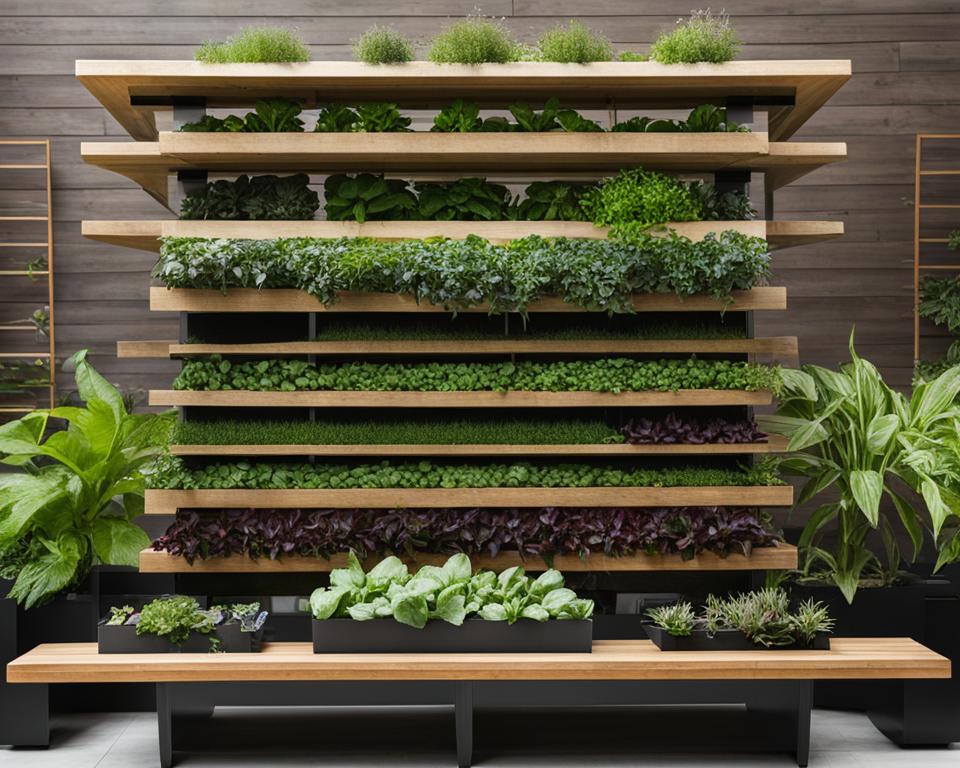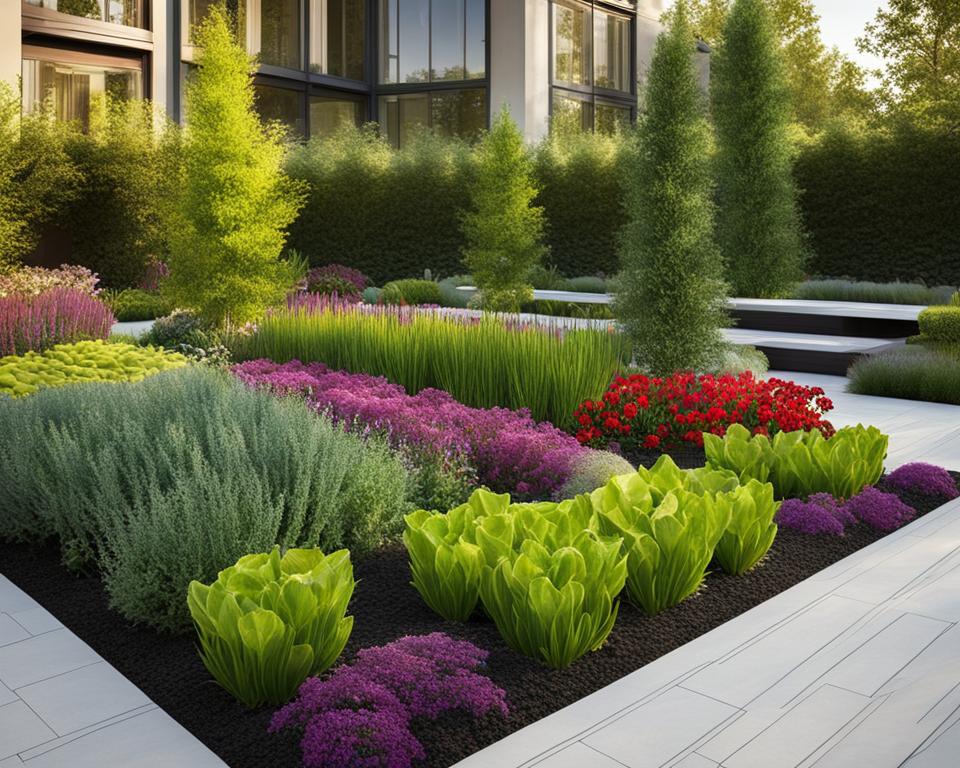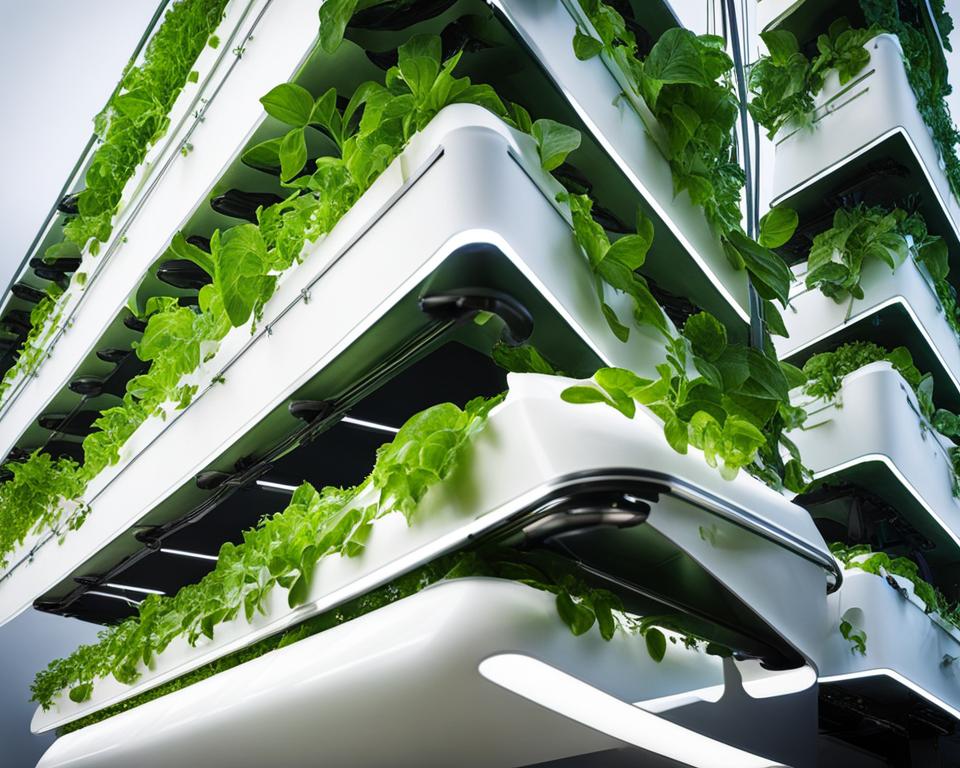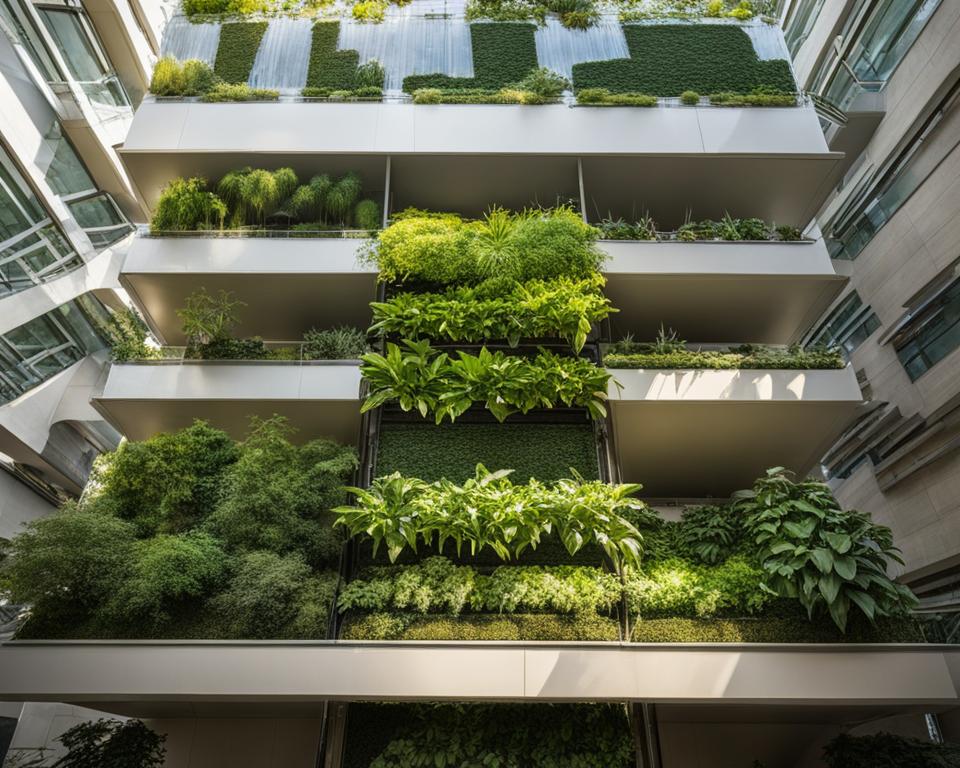Do you want to bring nature to your urban dwelling? Perhaps you are looking for an innovative way to grow a lush garden with limited space. Look no further! Vertical tower gardening is the perfect solution for you. With its practical design and sustainable features, this modern take on gardening is an excellent alternative for city dwellers looking for a way to engage in urban gardening. In this informative guide, we’ll walk you through everything you need to know to start reaping the benefits of your very own vertical garden, whether it is indoors or outdoors.
Key Takeaways
- Vertical tower gardening maximizes space by growing plants vertically, making it perfect for urban gardening.
- This clever alternative is adaptable for various settings, including indoor areas with limited space.
- Vertical gardening boasts sustainability features, such as resource efficiency and water conservation.
- Vertical tower gardens cater to a wide range of plants, including vegetables, fruits, and ornamentals.
- Starting your vertical garden can contribute to your overall wellness, eco-friendly lifestyle, and connection to nature.
Understanding Vertical Tower Gardening
With the growing interest in sustainable living and the increasing popularity of indoor gardening, vertical tower gardening has become a go-to solution for many gardening enthusiasts. In this section, we’ll provide a vertical tower gardening definition and dive into its numerous benefits.
What is Vertical Tower Gardening?
Vertical tower gardening is an innovative approach to traditional gardening that utilizes vertical space to cultivate plants. This method enables individuals to grow plants in stacked layers, maximizing the use of available space for a productive garden. Primarily suited for indoor gardening and urban spaces, vertical tower gardening systems often employ soil-less growing techniques, such as hydroponics, where plants are nourished with nutrient-rich water solutions instead of soil.
One might wonder what distinguishes vertical tower gardening from other forms of vertical farming. While both concepts focus on utilizing vertical space, vertical tower gardening often involves space-saving structures designed for individual and home use, whereas vertical farming typically refers to large, commercial-scale operations.
The Benefits of Going Vertical with Your Garden
Vertical tower gardening offers a range of advantages when compared to traditional gardening methods. Let’s explore some of the most significant tower gardening benefits.
- Space Efficiency: Space-saving gardening is one of the primary reasons many people turn to vertical tower gardening, especially in urban settings where outdoor space is limited. This method enables individuals to maximize the available area for a productive garden, whether on a patio, balcony, or even indoors.
- Sustainable Gardening: Vertical tower gardens contribute to a more sustainable lifestyle by efficiently utilizing resources. These systems typically require less water and soil compared to traditional gardens, and the reduced need for pesticides further lowers their environmental impact.
- Personalization: One of the most appealing aspects of tower gardening is the ability to customize the garden to suit individual preferences and dietary needs. A wide variety of plants can be grown, including leafy greens, herbs, fruits, and even ornamental plants for aesthetic appeal.
- Improved Plant Health: Due to the nature of vertical tower gardening methods, such as hydroponics, plants often receive optimal nutrient levels and oxygen, resulting in healthier growth and reduced risk of soil-borne diseases.
- Accessibility: Vertical tower gardens provide an accessible way for individuals with limited mobility or physical challenges to engage in gardening activities comfortably. The raised containers and stacked design can significantly reduce the need for bending and reaching, making the gardening experience more enjoyable and less strenuous.
In summary, vertical tower gardening is an innovative, space-saving approach to traditional gardening that promotes a sustainable lifestyle through the efficient use of resources. It offers numerous benefits including customization options, improved plant health, and increased accessibility, making it a popular choice for indoor and urban gardeners alike.
Choosing the Right Vertical Garden Systems

Selecting the appropriate vertical garden system for your specific needs is crucial to ensuring a successful and thriving garden. To help you make an informed decision, we’ll discuss the pros and cons of different types of garden systems, including traditional soil-based systems and innovative hydroponic solutions.
Traditional soil-based systems have been the norm for many years and can be highly effective for vertical gardens as well. The advantages of these systems include familiarity and a wider range of plant options for those already experienced in traditional gardening. The downside, however, is that soil-based gardens may require more space and natural resources, such as water, increasing the overall environmental impact.
Hydroponic gardening systems utilize a soilless growing medium and offer several advantages for vertical gardening. These systems consume less water, require less space, and can provide increased control over plant nutrition. On the other hand, hydroponic systems tend to have a steeper learning curve, and the initial setup and maintenance can be more expensive than traditional soil-based gardening.
When choosing the right vertical garden system, consider factors such as available space, budget, and the types of plants you wish to grow.
Next, let’s evaluate these garden systems based on specific features:
| Feature | Soil-Based Systems | Hydroponic Systems |
|---|---|---|
| Space Requirements | Generally requires more space | Space-efficient and compact |
| Water Consumption | Higher water consumption | Reduced water consumption |
| Plant Nutrition Control | Limited control | Increased control |
| Initial Setup Cost | Lower cost | Higher cost |
| Maintenance | Regular gardening upkeep | Additional monitoring required |
To decide which system to choose, consider the following questions:
- How much space can you dedicate to your vertical garden?
- What is your budget for the initial setup and ongoing maintenance?
- Are you interested in growing a variety of plants, or focusing on specific varieties that thrive in hydroponic systems?
- Are you willing to invest time in learning new gardening techniques if you opt for a hydroponic system?
Considering the answers to these questions will help you make an informed decision in choosing the right vertical garden system to suit your needs, preferences, and goals. Your perfect tower gardening setup awaits.
Step-by-Step Guide to Setting Up Your Vertical Garden

Creating your own vertical garden is an exciting journey, and getting started is easier than you might think. This step-by-step guide will walk you through the process of setting up a successful tower garden, from choosing a location to selecting the right plants. With the right approach and proper planning, you’ll have your vertical gardening space flourishing in no time.
Choosing the Perfect Location
One of the first decisions you’ll need to make is where to set up your tower garden. The ideal location depends on factors such as sunlight exposure, temperature, and convenience for maintenance. As you consider your options, keep these factors in mind:
Sunlight: Most plants require at least six to eight hours of sunlight per day for optimal growth. Observe how the sunlight moves through your space and choose a spot that receives consistent, direct light.
Temperature: Most tower garden plants grow best in temperatures between 65 and 75°F (18 and 24°C). Be mindful of spaces that get too hot or too cold during specific seasons, as this can affect plant health.
Convenience: You’ll need to access your garden for regular maintenance, watering, and harvesting. Make sure the location is convenient but also has enough room to maneuver around the tower.
Good location options for a tower garden may include balconies, patios, or indoor spaces near large windows that receive ample light.
Essential Supplies for Tower Gardening
Before you dive into setting up your vertical gardening space, gather the necessary supplies. Investing in high-quality, sustainable gardening tools and products ensures a successful and thriving garden. Here’s a checklist of items to get started:
- Vertical garden system (hydroponic or soil-based)
- Growing medium (soil, coco coir, or perlite)
- Seeds or starter plants
- Watering can or irrigation system
- Plant nutrients (for hydroponic systems)
- Pruner or scissors
- Protective gloves
Plant Selection for Your Tower Garden
Not all plants are suitable for vertical gardening. When selecting your tower garden plants, consider factors like lighting conditions, plant care requirements, and your personal gardening goals. You can opt for a mix of edibles, like herbs, fruits, and vegetables, or ornamental plants to create a visually stunning display.
| Plant Category | Examples |
|---|---|
| Herbs | Mint, basil, thyme, parsley, cilantro |
| Fruits and Vegetables | Strawberries, cherry tomatoes, peppers, lettuce, kale |
| Ornamental Plants | Ferns, succulents, bromeliads, trailing vines |
Remember to research the plants you’re interested in to ensure they’ll thrive in your selected tower garden location. With the right combination of plants, you’ll soon have a fruitful, sustainable, and beautiful vertical gardening space to enjoy.
Maintaining Your Vertical Garden for Maximum Yield

Maintaining your vertical garden is key to its success. Understanding the most effective watering strategies and nutrient management practices will help you maximize yield and maintain the health of your plants. In this section, we will explore the best methods for providing optimum moisture and nutrients to your vertical garden.
Watering Strategies for Vertical Gardening
Effective vertical gardening watering is crucial for plant health and to conserve valuable resources. Watering techniques for tower gardens can vary, but the primary goal is to ensure that each plant receives consistent and adequate moisture without wasting water. Some sustainable watering practices include:
- Manual Watering: Watering each plant individually at the base using a watering can or hose.
- Drip Irrigation: Installing a drip system that delivers water directly to the roots of each plant, reducing water waste and evaporation.
- Automatic Watering Systems: Customer-built or commercially-available systems that distribute water periodically, with minimal input from the gardener.
Consider the size, location, and plants in your vertical garden when choosing the most efficient watering method. Manual watering may be appropriate for small tower gardens, whereas automated systems might be better suited for larger or hydroponic gardens.
Nutrient Management in Vertical Farming
Proper nutrient management is essential for the health and productivity of your plants in a vertical farming system. This is particularly important in hydroponic gardening, where plants derive nutrients directly from water-soluble solutions rather than soil. The following tips can help maintain balanced nutrient levels:
- Research the specific nutrient requirements of your chosen plants, as different plants have varying needs.
- Use a high-quality hydroponic gardening nutrient solution, which typically contains key elements such as nitrogen, phosphorus, potassium, and trace minerals.
- Monitor the pH and nutrient levels in your hydroponic system regularly, adjusting as necessary to maintain the ideal balance for your plants’ growth.
Implementing sustainable nutrient management practices in your vertical garden will maximize efficiency and ensure that your plants thrive.
“The key to a successful vertical garden is understanding how to provide the right moisture and nutrients to create a thriving environment.” – Author Unknown
Vertical gardening may seem challenging at first, but with the right watering strategies and nutrient management techniques, you can maintain a lush and thriving vertical garden that contributes to a more sustainable and efficient urban lifestyle.
Innovative Techniques in Hydroponic Gardening

Hydroponic gardening has come a long way in recent years, with innovative techniques making it more accessible to a wider audience. In this section, we will explore some of the latest advancements in hydroponic gardening that can be integrated into vertical farming. These innovations have the potential to improve crop yields, reduce resource consumption, and simplify the gardening process.
Aeroponics: Taking Hydroponics to New Heights
Aeroponics is a cutting-edge hydroponic gardening innovation that involves suspending plant roots in air and misting them with nutrient-rich solution. This advanced vertical farming technique allows for faster growth rates, reduced water consumption, and less need for growing media. It also minimizes the risk of disease transmission between plants since there is little to no contact between root systems.
Nutrient Film Technique: A Continuous Flow System
The Nutrient Film Technique (NFT) is another innovative hydroponic system that uses a thin film of nutrient-laden water flowing continuously over the roots of plants. By keeping the roots consistently moist and well-nourished, this advanced vertical farming technique encourages robust growth, while still conserving water and nutrients compared to traditional hydroponic methods.
Vertical Nutrient Delivery Systems
Some hydroponic systems are specifically designed for vertical gardens, allowing for optimal nutrient delivery to each plant in the structure. These vertical nutrient delivery systems can include gravity-fed drip irrigation or advanced capillary mats that efficiently distribute the nutrient solution to each plant in a tower garden.
“Innovation is vital for the evolution of hydroponic gardening and vertical farming.”
Monitoring and Automation in Hydroponic Gardening
With the aid of technology, hydroponic gardeners can monitor and control various aspects of their gardens with ease. From monitoring nutrient concentrations to adjusting light intensity and managing irrigation, automation is quickly becoming an integral component of hydroponic gardening innovations.
Smartphone apps and IoT devices allow users to remotely monitor their vertical gardens and even adjust settings if necessary. Advanced hydroponic systems can be linked to sensors and controllers that keep tabs on the environment and alert users if an issue arises. This level of monitoring and automation simplifies the gardening process while helping to ensure optimal conditions for plant growth.
- Aeroponics for faster growth and reduced water consumption
- Nutrient Film Technique for efficient nutrient delivery
- Vertical nutrient delivery systems designed specifically for tower gardens
- Automation and monitoring technology for ease of management
In conclusion, hydroponic gardening innovations and advanced vertical farming techniques are transforming the way we approach urban agriculture. By keeping up with the latest developments in the field, you can improve your crop yields, reduce resource consumption, and simplify your gardening process, all while reaping the benefits of a greener, more sustainable lifestyle.
Embrace Vertical Gardening for a Sustainable Urban Lifestyle
With the knowledge and tools provided in this guide, you are now well-equipped to begin your journey into the world of vertical tower gardening. Starting your vertical garden is a significant step towards embracing a sustainable urban lifestyle, as it allows you to make the most of limited space while cultivating a fulfilling connection with the environment.
By carefully considering factors such as location, plant selection, and the right gardening system, you can create a thriving tower garden that suits your needs and preferences. Don’t be afraid to experiment with different types of plants, techniques, and equipment, as achieving vertical gardening success is a learning process that will ultimately lead to a rewarding experience and a flourishing garden.
So, go ahead and take the first steps into vertical tower gardening! As you embark on this exciting endeavor, remember the practical advice and insights shared in this guide. The rewards of a lush, productive vertical garden await you, contributing to a healthier, more sustainable urban lifestyle you can be proud of.
FAQ
What is Vertical Tower Gardening?
Vertical Tower Gardening is an innovative and space-saving method of growing plants by utilizing vertical space instead of traditional horizontal layouts. This technique is commonly used in urban and indoor gardening environments, where space may be limited. It often involves hydroponics, a soilless growing technique that delivers nutrients directly to the plant’s roots via a water-based solution.
What are the benefits of vertical tower gardening?
Vertical tower gardening offers many benefits, including maximizing space usage, making it ideal for urban or small living spaces. It also promotes sustainable gardening practices by conserving water and reducing the need for harmful pesticides. Additionally, vertical tower gardens can improve air quality, enhance the aesthetic of indoor or outdoor settings, and provide a continuous source of fresh produce for a healthy diet.
How do I choose the right vertical garden system?
To choose the right vertical garden system, you should consider factors such as the available space, the type of plants you want to grow, and your budget. Research different types of systems, including soil-based and hydroponic solutions, to determine which will best meet your specific needs. There are many products and DIY options available on the market, catering to different preferences and skill levels.
What is the ideal location for a vertical tower garden?
The perfect location for your vertical tower garden depends on factors such as sunlight exposure, temperature, and ease of access for maintenance. For outdoor gardens, consider placing your vertical garden on a balcony, patio, or dedicated garden space with sufficient sunlight. For indoor gardens, choose an area with ample natural light or invest in supplemental artificial grow lights to ensure your plants flourish.
What supplies will I need to begin a vertical tower garden?
Essential supplies for starting a vertical tower garden include the vertical garden system itself (whether store-bought or DIY), a quality growing medium such as soil or hydroponic solution, seeds or seedlings, appropriate garden tools, and proper gardening attire. Depending on the type of plants you choose, you may also need fertilizers, pruning shears, and pest control measures to maintain a healthy, flourishing garden.
What types of plants can I grow in a vertical tower garden?
A wide variety of plants can be grown in vertical tower gardens, including herbs, vegetables, fruits, and ornamental plants. When selecting plants for your tower garden, consider factors such as the growing conditions (light, temperature, humidity) in your space, as well as your personal gardening goals and preferences. A diverse range of plants can thrive in vertical tower gardens, allowing you to tailor your garden to your tastes and needs.
How do I properly water and maintain my vertical garden?
Efficient watering strategies are crucial for successful vertical tower gardening, ensuring your plants receive enough moisture while conserving water. Consider using automated watering systems or manual watering routines that save time and resources. Nutrient management is also essential, especially in hydroponic gardens—monitor and maintain nutrient levels to promote optimal plant health and productivity. Regularly check for pests and disease, and prune your plants as needed to encourage growth and maintain your garden’s overall health.
What are the latest innovations in hydroponic gardening?
The latest innovations in hydroponic gardening include advanced nutrient delivery systems, energy-efficient LED grow lights, and smart monitoring systems that allow you to control your garden’s conditions remotely. These advances in technology aim to improve crop yields, reduce resource consumption, and simplify the gardening process, making hydroponic gardening more accessible to a broader audience.

